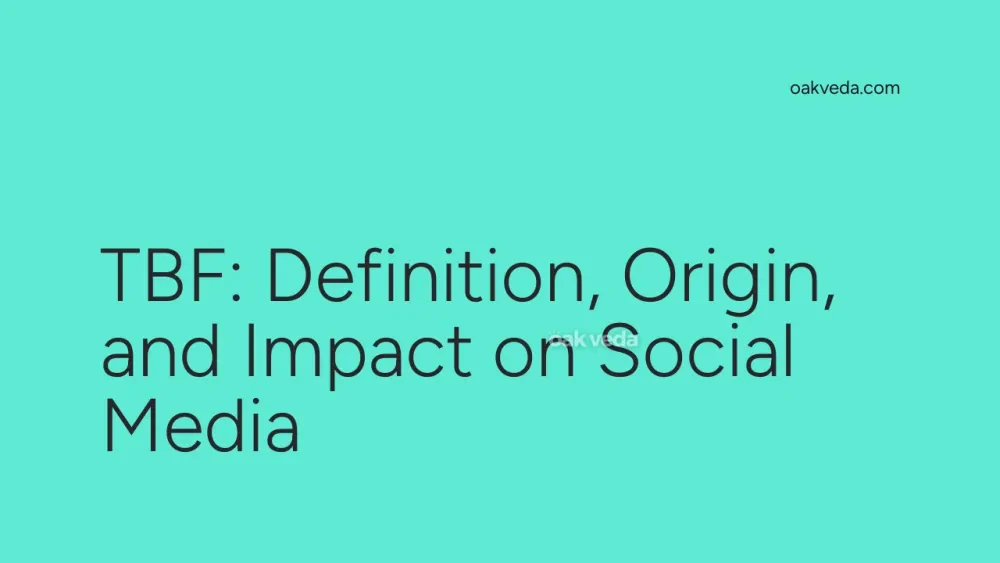
What is TBF?
TBF is an acronym that stands for "To Be Fair" in social media and online communication. It's a popular phrase used to preface a statement or opinion when acknowledging a different perspective or providing additional context. By using TBF, individuals aim to present a more balanced view or add information that may influence the interpretation of what was previously stated.
Origin and Development of TBF
The phrase "to be fair" has been used in spoken English for centuries, but its abbreviation "TBF" gained popularity with the rise of social media and text-based communication. As character limits and quick responses became the norm, acronyms like TBF emerged to convey common phrases efficiently.
The exact origin of TBF as an acronym is difficult to pinpoint, but it likely gained traction in the early 2000s with the proliferation of online forums, chat rooms, and text messaging. Its usage has since expanded across various social media platforms and has become a staple in digital communication.
How TBF Works
TBF is typically used at the beginning of a sentence or as a standalone response. It serves several purposes in online conversations:
- Introducing balance: TBF helps users present a more nuanced view of a situation.
- Acknowledging other perspectives: It shows that the speaker is considering alternative viewpoints.
- Softening criticism: TBF can be used to preface a critical statement, making it appear more considerate.
- Adding context: It allows users to provide additional information that may change the interpretation of a situation.
For example, someone might say, "TBF, while the movie had its flaws, the cinematography was outstanding." Here, TBF introduces a balanced perspective by acknowledging both negative and positive aspects.
Popular Examples of TBF
TBF is widely used across various social media platforms. Here are some common examples:
- On Twitter: "TBF, both candidates made some good points in the debate."
- In a Facebook comment: "TBF, the restaurant was understaffed, which might explain the slow service."
- On Instagram: "TBF, the filter does make the photo look better, but it's still a beautiful sunset."
- In a Reddit discussion: "TBF, the game developers have been working hard to fix the bugs."
Impact of TBF on Social Media Culture
The widespread use of TBF has had several impacts on social media culture:
- Promoting balanced discussions: TBF encourages users to consider multiple perspectives before forming opinions.
- Enhancing digital empathy: By acknowledging other viewpoints, TBF fosters more empathetic online interactions.
- Improving communication clarity: TBF helps users provide context and nuance in character-limited platforms.
- Reducing online conflicts: By presenting balanced views, TBF can help de-escalate heated online debates.
How Brands and Influencers Use TBF
Brands and influencers have recognized the value of TBF in their social media strategies:
- Addressing criticism: Brands use TBF to acknowledge customer complaints while providing context for their actions.
- Product reviews: Influencers use TBF to give balanced product reviews, highlighting both pros and cons.
- Crisis management: Companies employ TBF in their responses during PR crises to show they're considering all perspectives.
- Engagement boost: Using TBF in posts can encourage more nuanced discussions in the comments, increasing engagement.
For example, a brand might post: "TBF, while our latest product launch had some hiccups, we're grateful for your patience and are working hard to resolve all issues."
Future Trends Related to TBF
As social media continues to evolve, we can expect to see some trends related to TBF:
- Increased usage: As online discussions become more polarized, TBF may be used more frequently to promote balanced viewpoints.
- Platform-specific variations: Different platforms may develop their own versions or adaptations of TBF.
- Integration into AI: Chatbots and AI-driven customer service may incorporate TBF to provide more nuanced responses.
- Educational emphasis: Digital literacy programs may highlight the importance of using phrases like TBF to encourage critical thinking and balanced communication online.
FAQs about TBF
-
Is TBF only used on social media? While TBF is primarily used in online communication, it has started to appear in informal written communication and sometimes in spoken language.
-
Are there any alternatives to TBF? Yes, some alternatives include "In all fairness," "To be honest," (TBH), and "That being said."
-
Can TBF be used sarcastically? Yes, like many phrases, TBF can be used sarcastically to highlight an obvious point or to mock someone's attempt at balance.
-
Is TBF appropriate for professional communication? While TBF is generally informal, it's becoming more accepted in casual professional settings. However, it's best to use the full phrase "to be fair" in formal communication.
-
How does TBF differ from TBH (To Be Honest)? While both are used to preface statements, TBF is used to provide balance or context, while TBH is typically used to introduce a frank or potentially unpopular opinion.
In conclusion, TBF has become an integral part of social media language, promoting more balanced and nuanced online discussions. As digital communication continues to evolve, understanding and appropriately using acronyms like TBF can greatly enhance one's ability to engage effectively in online conversations and debates.
You may be interested in:
- @-Me: Definition, Origin, and Impact on Social Media
- Blue Checkmark: Definition, Origin, and Impact on Social Media
- Social Media Manager: Definition, Origin, and Impact
- That Girl: Definition, Origin, and Impact on Social Media
- "It's Whackadoodle Time": Definition, Origin, and Impact
- Dark Social: Definition, Origin, and Impact on Digital Marketing

